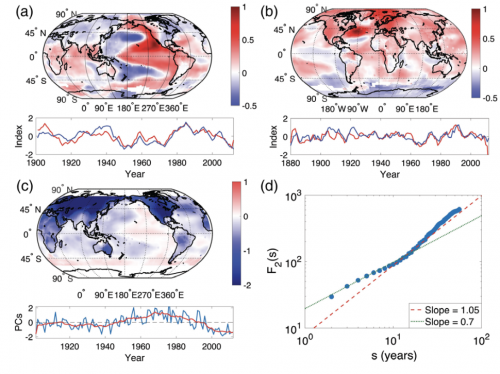A Historical and Statistical Study
Contrary to the name, pink noise isn’t referring to the music that blares out at a P!nk concert. Unlike the more commonly known white noise, which has equal power across frequencies, pink noise comes out louder and more powerful at lower sound frequencies. Scientifically, pink noise is considered random statistical noise and can be found in numerous biological settings—including steady rainfall, earthquakes, the luminosity of stars and, most importantly, in Earth’s climate.
Yale professor John Wettlaufer, Yale graduate student Sahil Agarwal, and Stockholm University Professor and Yale graduate Woosok Moon used a multifractal time-series method—analyzing climate data from successive, specific time intervals—and discovered patterns of pink noise in climate change data that measures the impact of humans on global warming.
The team first calculated the deviations in seasonal monthly averaged temperature data from up to 133 years ago for 79 locations across the globe. Specifically, they wanted to find temperature deviations that could be attributed to pink noise before and after the Industrial Revolution, allowing an analysis to determine exactly how much of climate change can be attributed to mankind. Through this multifractal time-series method, the team was able to track temperature change and other phenomena that contribute to climate volatility.
To determine whether pink noise could really be a factor that demonstrated humans have negatively contributed to climate change, the researchers analyzed past locations’ climates. Their analysis revealed that the way in which pink noise appears in the climate signal depends on geographic location. Additionally, because the same regions exhibited pink-noise characteristics regardless of timescales, it implies that pink noise is simply an internal characteristic of Earth’s climate system and did not arise from the Industrial Revolution and urbanization.
The implications for this research extends beyond linking pink noise and humankind’s impact. Because pink noise was found in the timescale before the Industrial Revolution and thus the advent of human-generated greenhouse gases, researchers can use the data to understand how pink noise can interact with human-generated greenhouse gases to change the Earth’s climate. Even though the researchers concluded that pink noise was naturally made, its interaction with other human-made substances may provide further insight into global warming. For example, it can indicate whether resonances—processes that couple and amplify global warming—occur when pink noise interacts with human-generated greenhouse gases, which could spur scientists to research other ways to reduce their interactions and thus reduce global warming amplification.
At this point, the researchers can only speculate that the noise may arise because of Earth’s rotation, but the team hopes to continue the investigation in the future.

